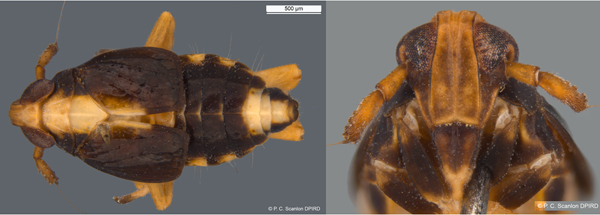Tarophagus spp
Taro planthoppers
Caution
Many of the insects depicted on these pages are outwardly similar and you should not use photographs as the sole means of identification. These pages form part of a scientific key which will assist a trained entomologist to identify the species accurately.
Tarophagus persephone (Kirkaldy, 1907)
Tarophagus colocasiae (Matsumura, 1932)
Tarophagus proserpina (Kirkaldy, 1907)
Common Name: Taro planthoppers
Subfamily/Tribe: Delphacinae: Delphacini
Distribution: The genus Tarophagus is principally found in south-east Asia and Oceania with two of the three known species occurring Australia. Tarophagus prosperina is found in PNG, Fiji, Samoa, Tahiti, New Caledonia, Vanuatu and the Cook Islands (Bartlett 2018 notes that although it has also been reported from Indonesia and Vietnam, these may be errors). Tarophagus persephone is recorded from Australia (Qld, NT), PNG, Borneo, Philippines, Solomon Islands, Malaysia and Indonesia. Tarophagus colocasiae has the largest range of the three species, having been recorded from Australia (Qld, Torres Strait Islands), PNG, Indonesia, Borneo, Philippines, Solomon Islands, Thailand, Taiwan, Belau, Guam, Micronesia, Marshall Islands, Hawaii, and recently spreading to Jamaica (2011), Cuba (2014), and mainland USA (Florida, 2015) (Halbert & Bartlett 2015; Bartlett 2018).
Economic Status: Tarophagus species feed on taro, Colocasia esculenta (Araceae), an important food crop across much of the Pacific region (Asche and Wilson 1989). The direct feeding can cause damage to host plants, particularly in heavy infestations (for symptoms see Plantwise 2018). Tarophagus planthoppers are vectors of Colocasia bobone disease rhabdovirus and Taro vein chlorosis rhabdovirus (Pearson et al. 1999: Matthews 2003; Tsatsia & Jackson 2017; Plantwise 2018). In addition, they may be potential vectors of taro feathery mottle virus (Halbert & Bartlett 2015) and Taro reovirus (Revill et al. 2004). All of these viruses are absent from Australia and can be lethal to host plants (Revill et al. 2004).
Notes: The genus contains only the three species treated here. Asche and Wilson (1989) note that Tarophagus are relatively easy to distinguish from other Delphacini genera based on the white dorsal stripe, the shape of male genitalia and two scale-like plates ventrally on the 6th abdominal segment of the female. Of note, species of Tarophagous can feed on some ornamental plants (e.g., elephant ears) and have been spread anthropogenically on these hosts (Halbert & Bartlett 2015).

Tarophagus colocasiae
